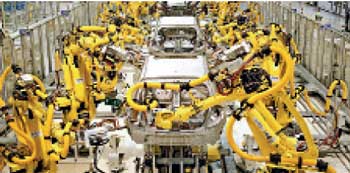17 Nov 2017 - {{hitsCtrl.values.hits}}
 BY Sher Singh Verick
BY Sher Singh Verick
Fears of technology-induced unemployment have penetrated media headlines and policy discourse in both advanced and developing countries.
In 2017, economists Carl Frey and Michael Osborne concluded that 47 percent of jobs in the United States were at high risk of automation. A range of replications and extensions have made similar claims. The World Development Report 2016 asserts that 68.9 percent of jobs in India are at high risk — and that number remains at 42.6 per cent even if adjusted for a lag in technology adoption. Is the world facing an onslaught of automation through robotics and artificial intelligence?
According to the International Federation of Robotics, robots are becoming more prevalent, but this is concentrated in a few industries in mostly advanced economies — China being the key exception. Of the 294,312 industrial robots sold in 2016, 74 percent were supplied to just five countries: China, South Korea, Japan, the United States and Germany. India accounted for only 2,627 robots sold in 2016, compared to 87,000 in China. In India, robots are helping automobile manufacturers, but few are found in more labour-intensive manufacturing industries, such as the garment sector.
Despite the rise of robotics in some countries, care is needed in interpreting the results of Frey and Osborne, which are based on technological feasibilities identified by experts. Their study did not take into account actual economic (or other) factors, such as relative costs, that could limit automation. Concluding that jobs can be automated doesn’t mean they will be in either the short or the long term.
Though technology is being adopted much faster across the globe than in earlier phases of the Industrial Revolution, diffusion within countries remains affected by various constraints. Small enterprises in developing countries operate far from the technology frontier and are prevented from accessing new technologies due to limited credit and access to information as well as other constraints. According to the World Bank Enterprise Survey in 2014, just 3.8 percent of small Indian firms with between five and 19 workers had licensed foreign technology compared to 20.5 percent for larger firms with 100 or more workers.
Policymakers should still be concerned about the impact of technology on employment, but rather than worrying about quantitative changes in employment, the main lesson is qualitative: technological change has historically hurt some workers while benefiting others. Previous waves of technological advancement did lead to the displacement of jobs but this was more than compensated by jobs created elsewhere in the economy. For instance, the automobile led to the demise of jobs for drivers of horse-drawn carriages, but this was offset by many other new jobs in auto-mechanics, motels and other new business forms.
But there isn’t sufficient evidence from developing countries to conclude that job polarisation driven by technological change is a universal phenomenon
Automation in more recent times appears to have brought about a polarisation of the labour market in the United States and Europe. Employment and sometimes wages have grown faster for not only high-skilled, non-routine occupations which rely more on cognitive skills (such as lawyers), but also low-skilled manual occupations in the service sector (such as food service operators). At the same time, employment has declined for medium-skilled, routine-based occupations which have been impacted the most by automation, such as machine operators and clerical jobs.
But there isn’t sufficient evidence from developing countries to conclude that job polarisation driven by technological change is a universal phenomenon. While we shouldn’t wildly speculate on the looming spectacle of jobs being replaced by robots, we do need to better monitor the qualitative impact of technology on jobs in developing countries. The future of automation, including robotics, in such places is unlikely to mirror trends from the United States and other high-income countries.
In developing countries, most people can’t afford to remain jobless. As a result, improving the quality of employment is a greater challenge than outright unemployment. As technology further advances, it will increasingly pay to be highly skilled. For this reason, enhancing educational outcomes and ensuring that skill development systems are demand driven continue to be key priorities. Labour market entrants and existing workers need the right skills to be complements rather than substitutes for new technologies.
Ultimately, we should resist the urge to be distracted by doomsday prophecies of the impending annihilation of jobs through automation. Smaller enterprises need better access to technology, which can increase their productivity and competitiveness, while also enhancing occupational health and safety in the workplace. Rather than fearing technology, policymakers in developing countries should continue to focus on the broader set of factors driving growth and job creation, of which technology is just one dimension.
(Courtesy East Asia Forum)
(Sher Singh Verick is a Visiting Fellow at the Australia South Asia Research Centre at the Crawford School of Public Policy, The Australian National University. He is also the Deputy Director of the International Labour Organisation’s Decent Work Team for South Asia and Country Office
for India)
25 Nov 2024 17 minute ago
25 Nov 2024 1 hours ago
25 Nov 2024 1 hours ago
25 Nov 2024 3 hours ago
25 Nov 2024 4 hours ago